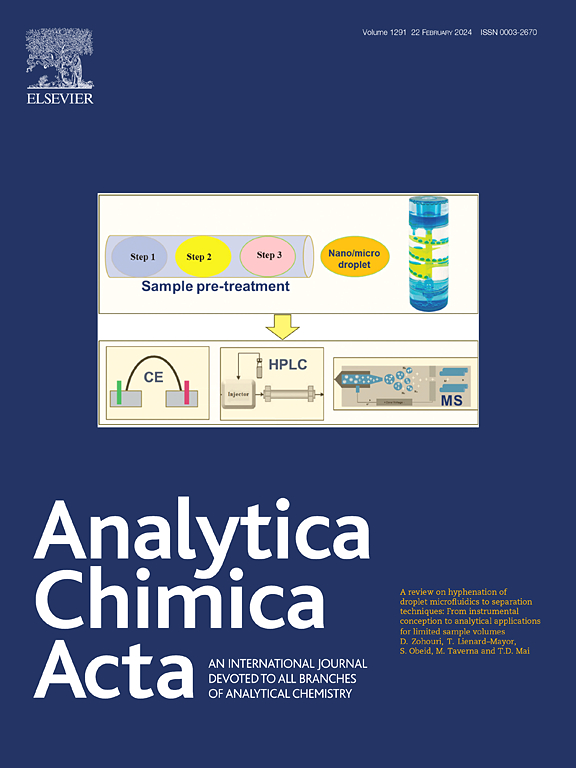Chemometrically assisted nanosensor for methotrexate determination in the presence of its molecular analog folic acid
IF 5.7
2区 化学
Q1 CHEMISTRY, ANALYTICAL
引用次数: 0
Abstract
Background
Methotrexate (MTX) is an antineoplastic drug used in high doses to treat different types of cancer. Its mechanism of action relies on the structural similarities to folic acid (FA), interfering in the metabolic pathway of FA. Due to the narrow therapeutic window and high cytotoxicity, MTX therapeutic drug monitoring is mandatory in high-dose administration schemes.
Results
A new nanosensor (NS) based on luminescent silver nanoclusters (AgNC) and metallic ions was developed to selectively determine MTX in samples containing its molecular analog FA. Notably, changes in the AgNC fluorescence signal are induced in the presence of MTX and FA, and this phenomenon was exploited to develop a sensing platform for quantitating non-fluorescent MTX in the presence of FA. The selectivity and sensitivity of the NS were improved by including Al3+ and Mg2+, and their concentrations were optimized by design-of-experiment and response surface methodology tools. Analysis of excitation-emission fluorescence matrices by Multivariate curve resolution-alternating least squares allowed exploiting the advantages of the analyte-induced fluorescence changes since it can cope with deviations from multilinearity occurring upon NS interaction with MTX. The sensing strategy reached limits of detection and quantitation of 0.3 μmol L−1 and 0.9 μmol L−1, respectively.
Significance
These findings support the method's applicability for quantitating MTX at clinically relevant concentrations in the presence of its molecular analog, without requiring exhaustive sample pretreatment. The developed sensing platform represents a simple, selective, sensitive, and cost-effective approach for quantitating non-fluorescent MTX in the presence of FA.

化学计量学辅助纳米传感器测定氨甲蝶呤在其分子类似物叶酸的存在
背景甲氨蝶呤(MTX)是一种高剂量的抗肿瘤药物,用于治疗不同类型的癌症。其作用机制依赖于与叶酸(FA)的结构相似性,干扰FA的代谢途径。由于MTX治疗窗口窄,细胞毒性高,在高剂量给药方案中,MTX治疗药物监测是强制性的。结果制备了一种基于发光银纳米簇(AgNC)和金属离子的新型纳米传感器(NS),可选择性地测定含有其分子类似物FA的样品中的MTX。值得注意的是,在MTX和FA存在的情况下,AgNC荧光信号会发生变化,这一现象被用来开发一个测量MTX在FA存在下的非荧光MTX的传感平台。Al3+和Mg2+的加入提高了NS的选择性和灵敏度,并通过实验设计和响应面法优化了它们的浓度。利用多元曲线分辨率-交替最小二乘分析激发-发射荧光矩阵,可以利用分析物诱导的荧光变化的优势,因为它可以处理NS与MTX相互作用时发生的多元线性偏差。检测限和定量限分别为0.3 μmol L-1和0.9 μmol L-1。这些发现支持该方法适用于在存在其分子类似物的情况下定量临床相关浓度的MTX,而不需要详尽的样品预处理。开发的传感平台代表了一种简单,选择性,敏感性和成本效益的方法,用于在FA存在下定量非荧光MTX。
本文章由计算机程序翻译,如有差异,请以英文原文为准。
求助全文
约1分钟内获得全文
求助全文
来源期刊

Analytica Chimica Acta
化学-分析化学
CiteScore
10.40
自引率
6.50%
发文量
1081
审稿时长
38 days
期刊介绍:
Analytica Chimica Acta has an open access mirror journal Analytica Chimica Acta: X, sharing the same aims and scope, editorial team, submission system and rigorous peer review.
Analytica Chimica Acta provides a forum for the rapid publication of original research, and critical, comprehensive reviews dealing with all aspects of fundamental and applied modern analytical chemistry. The journal welcomes the submission of research papers which report studies concerning the development of new and significant analytical methodologies. In determining the suitability of submitted articles for publication, particular scrutiny will be placed on the degree of novelty and impact of the research and the extent to which it adds to the existing body of knowledge in analytical chemistry.
 求助内容:
求助内容: 应助结果提醒方式:
应助结果提醒方式:


